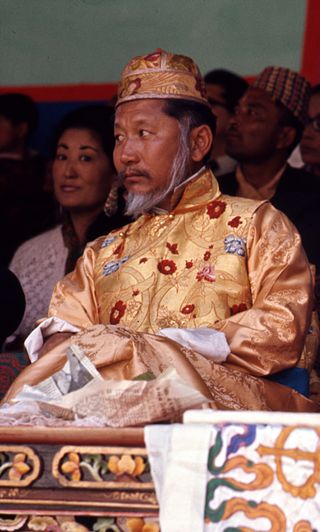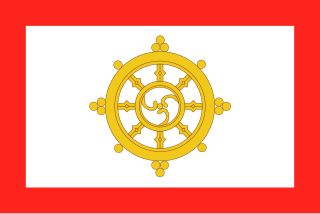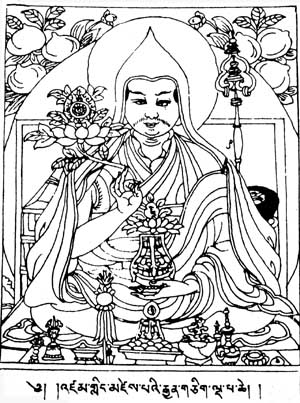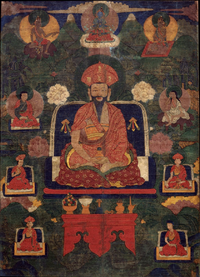
Bhutan's early history is steeped in mythology and remains obscure. Some of the structures provide evidence that the region has been settled as early as 2000 BC. According to a legend it was ruled by a Cooch-Behar king, Sangaldip, around the 7th century BC, but not much is known prior to the introduction of Tibetan Buddhism in the 9th century, when turmoil in Tibet forced many monks to flee to Bhutan. In the 12th century, the Drukpa Kagyupa school was established and remains the dominant form of Buddhism in Bhutan today. The country's political history is intimately tied to its religious history and relations among the various monastic schools and monasteries.

Palden Thondup Namgyal was the 12th and last Chogyal (king) of the Kingdom of Sikkim.

Tashi Namgyal was the ruling Chogyal (King) of Sikkim from 1914 to 1963. He was the son of Thutob Namgyal. He was the first independent king of Sikkim.

Hope Cooke was the Gyalmo of the 12th Chogyal (King) of Sikkim, Palden Thondup Namgyal. Their wedding took place in March 1963. She was termed Her Highness The Crown Princess of Sikkim and became the Gyalmo of Sikkim at Palden Thondup Namgyal's coronation in 1965.
Namgyal, a Tibetan deity, has been a personal name in several countries; see :

Ngawang Namgyal (1594–1651), known colloquially as The Bearded Lama, was a Tibetan Buddhist Drukpa Kagyu school Rinpoche, and the unifier of Bhutan as a nation-state. He was later granted the honorific title Zhabdrung Rinpoche, approximately "at whose feet one submits"). In addition to unifying the various warring fiefdoms for the first time in the 1630s, he also sought to create a distinct Bhutanese cultural identity separate from the Tibetan culture from which it was derived.

The history of Sikkim begins with the indigenous Lepcha's contact with early Tibetan settlers. Historically, Sikkim was a sovereign Monarchical State in the eastern Himalayas. Later a protectorate of India followed by a merger with India and official recognition as a state of India. Lepchas were the main inhabitants as well as the Ruler of the land up to 1641. Lepchas are generally considered to be the first people, indigenous to Sikkim also includes Darjeeling.

Rabdentse was the second capital of the former Kingdom of Sikkim from 1670 to 1814. The capital city was destroyed by the invading Gurkha army and only the ruins of the palace and the chortens are seen here now. However, the ruins of this city are seen close to Pelling and in West Sikkim district in the Northeastern Indian state of present-day Sikkim; Pemayangtse Monastery is one of the oldest monasteries in Sikkim which is close to the ruins. From the vantage point of this former capital, superb views of the Khanchendzonga ranges can be witnessed. This monument has been declared as of national importance by the Archaeological Survey of India. It was first established in 1670 by the 2nd Chogyal Tensung Namgyal son of the 1st Chogyal Phuntsog Namgyal by shifting from the first capital of Yuksom that was consecrated in 1642.

Zhabdrung was a title used when referring to or addressing great lamas in Tibet, particularly those who held a hereditary lineage. In Bhutan the title almost always refers to Ngawang Namgyal (1594–1651), the founder of the Bhutanese state, or one of his successive reincarnations.

Phuntsog Namgyal (1604–1670) was the first Chogyal (monarch) of Sikkim, now an Indian state. He consecrated in 1642 at the age of 38. Phuntsog was a fifth generation descendant of Khye Bumsa, a 13th-century prince from the Mi-nyak House in Kham in Eastern Tibet. According to legend, Guru Rinpoche, a 9th-century Buddhist saint had foretold the event that a Phuntsog from the east would be the next chogyal of Sikkim. In 1642, three lamas, from the north, west, and south went in search for the chosen person. Near present-day Gangtok, they found a man churning milk. He offered them some refreshments and gave them shelter. So impressed were they by his deeds that they realised that he was a chosen one and immediately crowned him king. The crowning took place Norbughang near Yuksom on a stone slab in a pine covered hill, and he was anointed by sprinkling water from a sacred urn.
Tensung Namgyal (1644–1700) was the second Chogyal (monarch) of Sikkim. He succeeded his father Phuntsog Namgyal in 1670 and moved the capital from Yuksom to Rabdentse near Geyzing. He had three wives from Bhutan, Nambi Onmo, Tibet, Lhacham Pema Putik, and a Limbu princess from the Arun valley, Thungwamukma. After establishing Rabdentse as his new capital he built a palace and asked his Limbu Queen to name it. She named it "Song Khim" which in Limbu language means "New Palace". This later went on to become "Sukhim" and "Sikkim". He was succeeded by his son Chakdor Namgyal, borne by his second wife in 1700. He had one last son with his third wife. Though he is not well known his grandson becomes a king of a small kingdom inside his father's rule.

Tashi Namgyal Academy (TNA) is a public school in the Himalayan state of Sikkim in India. It was founded in 1926 by the late Sir Tashi Namgyal, KCSI, KCIE, the 11th consecrated Ruler of Sikkim. It is an autonomous English-medium, co-educational and residential-cum-day school.

Chogyal Wangchuk Tenzing Namgyal is the second son of Palden Thondup Namgyal, the last sovereign king of Sikkim. Educated at Harrow, he is also the present heir of the Namgyal dynasty and pretender to the throne of Sikkim.

The Namgyal dynasty was a dynasty whose rulers were the monarchs of the former kingdom of Ladakh that lasted from 1460 to 1842 and were titled the Gyalpo of Ladakh. The Namgyal dynasty succeeded the first dynasty of Maryul and had several conflicts with the neighboring Mughal Empire and various dynasties of Tibet, including the Tibet–Ladakh–Mughal War. The dynasty eventually fell to the Sikh Empire and Dogras of Jammu. Most of its known history is written in the Ladakh Chronicles.

The Kingdom of Sikkim, officially Dremoshong until the 1800s, was a hereditary monarchy in the Eastern Himalayas which existed from 1642 to 16 May 1975, when it was annexed by India. It was ruled by Chogyals of the Namgyal dynasty.
Phuntsog Namgyal II was the fifth Chogyal (king) of Sikkim. He succeeded Gyurmed Namgyal in 1733 and was succeeded himself by Tenzing Namgyal in 1780.
Tenzing Namgyal was the sixth Chogyal (king) of Sikkim. He succeeded Phuntsog Namgyal II in 1780 and was succeeded himself by Tsugphud Namgyal in 1793.

The Dual System of Government is the traditional diarchal political system of Tibetan peoples whereby the Desi coexists with the spiritual authority of the realm, usually unified under a third single ruler. The actual distribution of power between institutions varied over time and location. The Tibetan term Cho-sid-nyi literally means "both Dharma and temporal," but may also be translated as "dual system of religion and politics."
A referendum on abolishing the monarchy was held in the Kingdom of Sikkim on 14 April 1975. Official results stated the proposal was approved by 97.55% of voters with a turnout of about 63%, and resulted in the country becoming an Indian state.

Jahan Bagcha Teesta Rangeet is a song that serves as the de facto state song for Sikkim, India.


























